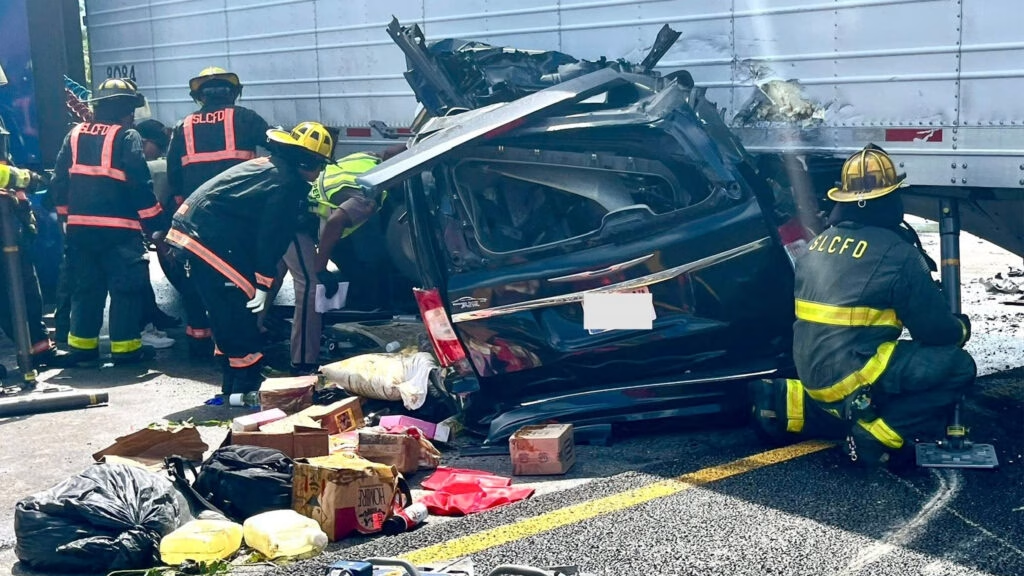What Went Wrong During the Florida Truck U-Turn Crash?
Dashcam footage from Florida’s Turnpike captured a moment that would change several lives forever. A semi-truck, driven by Harjinder Singh, attempted an illegal U-turn across the highway. The maneuver, made from the right lane at an “official use only” turnaround, was meant strictly for emergency vehicles. But Singh, seemingly without checking his mirrors, swung the massive rig across traffic. A black Chrysler minivan, traveling in the left lane, had no time to react. The result? A devastating collision that instantly claimed three lives inside the minivan.
Why Are U-Turns by Trucks So Dangerous on Highways?
It’s easy to underestimate just how risky a truck’s U-turn can be, especially on high-speed roads. Tractor-trailers are enormous—often weighing up to 80,000 pounds when fully loaded. Their turning radius is huge, and their blind spots can swallow entire vehicles. When a truck attempts a U-turn, it blocks multiple lanes for an extended period. On a busy highway, even a few seconds can mean the difference between a close call and a tragedy.
According to the Federal Motor Carrier Safety Administration, improper turns and illegal maneuvers by commercial vehicles are a leading cause of fatal crashes involving large trucks. In 2022, over 4,700 people died in crashes involving large trucks in the U.S., with a significant portion linked to driver error or reckless decisions. The Florida incident is a stark reminder: a single lapse in judgment behind the wheel of a big rig can have catastrophic consequences.
Who Were the Victims and What Happened After the Crash?
The minivan’s driver, a 30-year-old man from Florida City, was rushed to HCA Florida Lawnwood Hospital but later died from his injuries. Two passengers—a 54-year-old man from Miami and a 37-year-old woman from Pompano Beach—were killed instantly. Singh and his male passenger walked away without injury.
Law enforcement moved quickly. Singh was arrested at the scene and charged with three counts of vehicular homicide. Investigators also discovered that Singh had been living in the U.S. illegally since 2018, despite holding a commercial driver’s license issued in California. He now faces both criminal charges and possible deportation.
How Do Authorities Respond to Reckless Truck Driving?
The Florida Department of Highway Safety and Motor Vehicles (FLHSMV) called Singh’s actions both shocking and criminal. Executive Director Dave Krener emphasized the ripple effect of such tragedies—not just for the victims, but for their families and communities. In Florida, vehicular homicide is a serious felony, carrying the potential for lengthy prison sentences.
Beyond criminal prosecution, incidents like this often prompt reviews of commercial driver licensing and training standards. Federal and state agencies may investigate how someone with an undocumented status obtained a commercial license, and whether additional safeguards are needed to prevent similar cases.
What Can Drivers Learn from This Tragedy?
For truckers, the lesson is clear: shortcuts and illegal maneuvers are never worth the risk. Commercial drivers are held to a higher standard for a reason. Their vehicles can cause far more damage in a crash, and their decisions carry extra weight. Even a momentary lapse—like failing to check mirrors or misjudging traffic—can be fatal.
For everyday drivers, it’s a sobering reminder to stay alert around large trucks. Give them plenty of space, avoid lingering in blind spots, and be wary whenever you see a truck maneuvering across multiple lanes. Defensive driving isn’t just about protecting yourself—it’s about anticipating the mistakes of others.
Are There Steps Being Taken to Prevent Similar Crashes?
In recent years, Florida has increased enforcement around highway turnarounds, especially those marked for official use only. State troopers regularly ticket drivers who misuse these areas. Meanwhile, the trucking industry continues to invest in safety technology—like blind spot cameras and collision warning systems—to help drivers make better decisions.
But technology can only go so far. Ultimately, safety comes down to training, vigilance, and a culture of responsibility. The American Trucking Associations and other industry groups have called for stricter vetting of commercial drivers and more robust ongoing education. Some states are piloting programs that use AI-powered cameras to monitor risky maneuvers in real time, flagging violations before they turn deadly.
What’s the Real Impact on Families and Communities?
Behind every headline about a highway crash are families left to pick up the pieces. The sudden loss of three lives in this Florida tragedy has left a permanent scar on their loved ones. Grief, anger, and a search for answers follow in the wake of such senseless events. Community support groups and victim advocacy organizations often step in to help, but the pain lingers.
The big takeaway? Highway safety isn’t about perfection—it’s about smarter adjustments. Start with one change this week, whether it’s double-checking your mirrors or giving trucks a wider berth, and you’ll likely spot the difference by month’s end. Every small step counts when lives are on the line.

